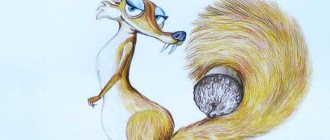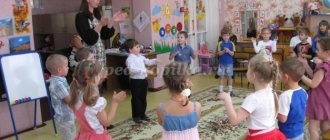Preview:
Lesson notes for the senior group “Cat on the Window”
(using non-traditional drawing methods (semolina)
Preliminary work: looking at pictures of a cat with children. Reading - S. Marshak “Mustachioed - Striped”, memorizing nursery rhymes about a cat.
Equipment and materials: board, pictures of a cat, white cardboard, PVA glue, sockets for semolina, sockets for glue, gouache, paint brushes, cups, napkins.
Children come in and sit down and say hello.
Educator: The cat is sleeping, she's going to get rid of the mice, don't wake her up! Hush hush! Let him sleep and dream, let him chase mice in his sleep! Today we will draw, as you already guessed... (on the board there is an image of a sleeping cat, previously made by the teacher as a sample).
Educator: That's right, a cat. Is a cat a domestic or wild animal? Why?
Children: Homemade, because he lives at home.
Educator: Let's ask those guys who have a cat at home to tell us about it. What's the name, what kind of fur, what kind of eyes? What does the cat like to eat and drink, and how does it play? What is her character like?
On the topic: methodological developments, presentations and notes
Summary of GCD in the senior group using non-traditional methods of drawing "Winter's Tale".
The lesson introduces children to one of the non-traditional drawing techniques. Practices combining different drawing techniques. Develops a sense of color and texture.
Goal: to expand the knowledge of teachers about non-traditional methods of drawing in working with preschool children with visual impairments. Objectives: - to introduce special knowledge and practical knowledge.
Preschool childhood is a very important period in the life of children. It is at this age that every child is a little explorer, discovering things with joy and surprise.
Abstract of the GCD on the artistic and aesthetic development of children in the senior speech therapy group using the non-traditional method of drawing “Knotted Batik”.
Notes on drawing in the senior group using non-traditional drawing techniques “Snowman”.
Source
Non-traditional drawing in the senior group with wax pencils “Cat”
Svetlana Demidova
Non-traditional drawing in the senior group with wax pencils “Cat”
1. Strengthen drawing skills using an unconventional technique - wax pencils, which allows you to most clearly convey the depicted object, the characteristic texture of its appearance (volume, fluffiness)
2. Continue learning to draw large, position the image in accordance with the size of the sheet.
3. Expand knowledge about pets, instill love for them.
4. Develop children's creative imagination, create conditions for the development of creative abilities.
5. Develop visual skills and abilities, fine motor skills of the hands.
6.. Foster accuracy and independence;
7. Cultivate an emotionally positive attitude towards work.
Materials for the lesson : wax pencils, colored cardboard, PVA glue, hard brush, brush stand, wet wipe.
Preliminary work: watching cartoons, looking at illustrations, reading fiction about animals; games with cat toys, playing with them.
1. Move : Game “Hello, friend!”
Hello Friend! (Children stretch out their right hand to the side.)
Hello Friend! (Extend left arm to the side.)
Get in a circle quickly, (Hold hands.)
We'll go in a circle (They go in a circle.)
- Let's smile at each other and start our lesson. I want you to succeed and have a good mood all day!
- Guys, someone is coming to visit us. Want to know who it is? Then guess my riddle:
Indeed, a cat came to our group. Do you know her name? Her name is Murka. I met her this morning, near the kindergarten, so beautiful, elegant, but sad. It turns out she has no friends at all. When I found out this, I really wanted to help her. Guys, let’s help our Murka find friends together, but first I suggest cheering her up a little, playing the game “Cat Habits.”
Preview:
Artistic and aesthetic development (Drawing)
Topic: “Cats on the window”
Goal: teach children to draw using a tampon on a stencil.
— to help children, during the lesson, learn new information about the cat as an animal, and be able to choose words that characterize the cat;
— introduce children to V. Suteev’s new fairy tale “The Mouse and the Pencil”;
- develop children's spoken language, memory, logical thinking, and creative imagination;
— consolidate the skills of painting by poking the office;
- develop a kind and sensitive attitude towards animals.
Materials: a sheet of A4 paper, a stencil with an image of a cat, gouache, a piece of foam rubber and all drawing supplies.
Watching cats at home or on a walk.
Talk about domestic cats, organize an exhibition of your pets.
Play the didactic game “Say the Word”
Reading the fairy tale by V. Suteev “The Mouse and the Pencil”
(The teacher and children sit in a semicircle on chairs)
Educator: Children, we know that it’s winter outside our window, it’s cold, it’s snowing, there’s a blizzard. Close your eyes, relax, imagine that you are at home. The stove is heated at home, it’s warm (And there’s a blizzard outside). Your home is comfortably clean (and it’s snowing outside). There is silence and peace at home (and there is a blizzard outside). And who is next to you (open your eyes).
Children: We have dad and mom at home!
Educator: Children, who else lives in the house with you?
Children: Cat, dog, parrot...
Educator: Children, today we will talk about cats
Educator: Who has a cat or cat living at home? (children's answers are heard)
Educator: Children, tell us about your friend?
Educator: Misha, tell me, who lives in your house? What color is your cat? What's your cat's name?
Educator: Damir, tell us about your cat. Nastya, tell me about your cat (Children write a short story about their cats).
Educator: Children, why is there a cat living in your house?
Children: The cat is a pet!
Educator: Why do we call cats pets?
Children: because cats live next to people, in the house, people take care of them.
Educator: How do people take care of them?
Children: Feed, caress, play, treat
Educator: What do your cats do?
Children: play, sing songs, wash themselves, catch mice.
Educator: Children, and also cats, see well in the dark, they have good hearing, cats can climb trees, love warmth, in winter they warm themselves by the stove, near the radiator, and in the summer, where do they warm themselves?
Educator: What do cats do when you pet them?
Children: Arch their backs, rub against their legs, scratch.
Educator: What do cats like to eat?
Children: milk, sausage, sour cream.
Educator: I also have a cat and her name is Murka. (showing the children a soft toy) Maybe we can play with Murka. (I’m conducting a didactic game “Say the Word”)
Educator: Children, let’s stand in a circle, look at the cat Murka and say kind words to the cat Murka. (What is she like?)
Children: (They pass the cat around in a circle and call it affectionately) Kind, fluffy, affectionate….
Educator: But children, “Stuffed Toy Store” (I show it to the children), come and touch the cats. What are they?
Educator: Children, I want to show you an exhibition of photographs of cats (showing). Children, look carefully at the cats, and here, what kind of cats are they? How many cats are there, can you count them?
Children: (Children's answers)
Educator: Maxim, what kind of cat do you like here? Describe the cat so that you can guess what kind of character the cat has? What is she doing? What's her name?
Educator: What else can you say about a cat?
Children: children's answers (children take turns describing the cat they liked)
Educator: Children, maybe we can now be wizards and turn into cats ourselves, I’ll draw you a mustache and play funny kittens (children stand in a circle, I draw mustaches for the children with a cosmetic pencil)
Educator: Children, look at each other, how beautiful and cheerful we are
Improvisation to the music “And that’s how it is.”
Educator: How does the cat walk?
Children: And like this (show)
Educator: And how he sleeps, how he washes himself, and how he laps milk, and how he smiles, etc.
And then the outdoor game “One, two, three, cat catch up with the mouse” is played.
We choose a mouse or a cat according to the children's wishes.
Educator: Children, we told you that cats are fluffy and soft. How to depict the fluffiness of a cat
Children: Poking method
Educator: How is this?
Children: Pick up paint on a dry sponge and hit it on the paper, holding the sponge vertically.
Educator: Children, sit down at the tables, close your eyes, imagine your cat, what kind of cat you want to draw. Start drawing.




